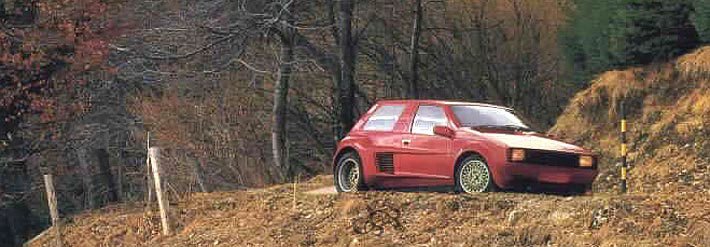Rare Rides: The 1980 Sbarro Super Eight, Not Your Standard Hatchback

The Eighties were the decade that saw the dawn of the hot hatchback. Today’s little red hatchback is really very hot, because it’s entirely a Ferrari 308 underneath.
Called the Super Eight, the ride you see here was a custom creation of Francisco Sbarro, whose work we featured for the first time the other day in the Berlingo Calao. While that van-cum-beach vehicle was meant for windsurfing and general leisure, the Super Eight was built to perform while looking fairly common.
Sbarro created the Super Eight for the 1984 edition of the Geneva Motor Show. He took a contemporary 1980 Ferrari 308 GTB (1975-1985) and replaced its angular Pininfarina-penned coupe body with a two-seat hatchback one of his own design. The Super Eight looked striking with gold lace alloys right at the corners of the body, which were fitting alongside all the spoilers, intakes, louvers, and a custom heckblende.
The donor 308 GTB was one of the naturally aspirated 308 versions and used Ferrari’s 2.9-liter V8 engine. The Super Eight kept the 308s transverse engine layout, and the five-speed Ferrari manual as well. The engine produced 252 horses in its Euro specification; smog-choked Americans at the time made do with 237.
Sbarro fitted an interior of his own design, complete with a center stack not found in the 308. Brown was the color scheme of choice, whether that be leather, wood, or tweedy cloth seat inserts. Two passengers could put their luggage at the rear above the engine where it would probably get hot, or in the carpeted front trunk where it would remain a bit cooler. Dials and switches were sensibly ported over from Ferrari, even if the overall interior design was not. The rear lamps look very familiar but your author can’t place them.
A one-off, the Super Eight was destined mostly for show and museum duty. Since 1984, it’s traveled about 16,700 miles. It’s presently for sale in Holland, it asks a stiff $179,000.
[Images: Sbarro, YouTube]

Interested in lots of cars and their various historical contexts. Started writing articles for TTAC in late 2016, when my first posts were QOTDs. From there I started a few new series like Rare Rides, Buy/Drive/Burn, Abandoned History, and most recently Rare Rides Icons. Operating from a home base in Cincinnati, Ohio, a relative auto journalist dead zone. Many of my articles are prompted by something I'll see on social media that sparks my interest and causes me to research. Finding articles and information from the early days of the internet and beyond that covers the little details lost to time: trim packages, color and wheel choices, interior fabrics. Beyond those, I'm fascinated by automotive industry experiments, both failures and successes. Lately I've taken an interest in AI, and generating "what if" type images for car models long dead. Reincarnating a modern Toyota Paseo, Lincoln Mark IX, or Isuzu Trooper through a text prompt is fun. Fun to post them on Twitter too, and watch people overreact. To that end, the social media I use most is Twitter, @CoreyLewis86. I also contribute pieces for Forbes Wheels and Forbes Home.
More by Corey Lewis
Latest Car Reviews
Read moreLatest Product Reviews
Read moreRecent Comments
- Lou_BC Well, I'd be impressed if this was in a ZR2. LOL
- Lou_BC This is my shocked face 😲 Hope formatting doesn't fook this up LOL
- Lou_BC Junior? Would that be a Beta Romeo?
- Lou_BC Gotta fix that formatting problem. What a pile of bullsh!t. Are longer posts costing TTAC money? FOOK
- Lou_BC 1.Honda: 6,334,825 vehicles potentially affected2.Ford: 6,152,6143.Kia America: 3,110,4474.Chrysler: 2,732,3985.General Motors: 2,021,0336.Nissan North America: 1,804,4437.Mercedes-Benz USA: 478,1738.Volkswagen Group of America: 453,7639.BMW of North America: 340,24910.Daimler Trucks North America: 261,959







































Comments
Join the conversation
This thing rules.
1980 was time when small and fast car cames widely in public in Europe. Who remembers Vauxhall Chevette HSR, Renault R5 Turbo, Peugeot 205 Turbo, Ford Escort RS2000, MG Metro Turbo, Opel Kadett GT/E, Lancia Delta, Fiat Ritmo Abarth...and all of them were really fast and leave Ferrari, Lamborghini, Lotus, BMW M, Maserati...owners thinking in traffic lights. End of that era Citroen introduced Citroen Xantia V6 Activa with extension to the Hydractive II suspension, where two additional spheres and two hydraulic cylinders are used together with computer control to eliminate body roll completely. Xantia was a family car and it still leaves even todays supercars behind in twisty road. The Citroën Xantia V6 Activa still holds the record speed (85 km/h (53 mph)) through the moose test maneuver, due to its active anti-roll bars. This test is conducted by the Swedish magazine Teknikens Värld's, as a test of avoiding a moose in the road. The second place car, Porsche 997 GT3 RS was able to manage 82 km/h (51 mph)).